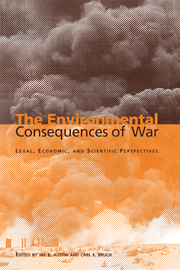Book contents
- Frontmatter
- Contents
- List of illustrations
- List of tables
- List of contributors
- Acknowledgements
- Foreword by Klaus Toepfer
- Introduction
- Part I General principles
- Part II The legal framework
- Introduction
- 2 The law of war and environmental damage
- 3 War and the environment: fault lines in the prescriptive landscape
- 4 The inadequacy of the existing legal approach to environmental protection in wartime
- 5 United States Navy development of operational-environmental doctrine
- 6 In furtherance of environmental guidelines for armed forces during peace and war
- Introduction
- 7 Peacetime environmental law as a basis of state responsibility for environmental damage caused by war
- 8 Environmental damages under the Law of the Sea Convention
- 9 The place of the environment in international tribunals
- 10 Civil liability for war-caused environmental damage: models from United States law
- Part III Assessing the impacts – scientific methods and issues
- Part IV Valuing the impacts – economic methods and issues
- Part V Prospects for the future
- Index
9 - The place of the environment in international tribunals
Published online by Cambridge University Press: 04 August 2010
- Frontmatter
- Contents
- List of illustrations
- List of tables
- List of contributors
- Acknowledgements
- Foreword by Klaus Toepfer
- Introduction
- Part I General principles
- Part II The legal framework
- Introduction
- 2 The law of war and environmental damage
- 3 War and the environment: fault lines in the prescriptive landscape
- 4 The inadequacy of the existing legal approach to environmental protection in wartime
- 5 United States Navy development of operational-environmental doctrine
- 6 In furtherance of environmental guidelines for armed forces during peace and war
- Introduction
- 7 Peacetime environmental law as a basis of state responsibility for environmental damage caused by war
- 8 Environmental damages under the Law of the Sea Convention
- 9 The place of the environment in international tribunals
- 10 Civil liability for war-caused environmental damage: models from United States law
- Part III Assessing the impacts – scientific methods and issues
- Part IV Valuing the impacts – economic methods and issues
- Part V Prospects for the future
- Index
Summary
Introduction
War can be destructive not only to lives and property, but also to the more fundamental structure of our world, the environment. In attempting to address the consequences of war for the environment, one may try to prevent war from starting or to prevent an ongoing war from extending to particularly sensitive environments. This chapter assumes that the prevention effort has failed at least in part and that one therefore must also consider (1) the mitigation of the consequences that flow from the harm to the environment, (2) the possible restoration of the environment harmed, and (3) legal and financial responsibility for such mitigation and restoration as a possible deterrent. In all three of these areas, international adjudication can play a role.
In the twentieth century, there have been numerous international adjudicatory institutions created to address international wrongs. These include ad hoc arbitrations, claims commissions, and permanent tribunals. Sometimes these mechanisms were employed to resolve a specific question, such as a boundary dispute. Often these mechanisms followed particularly earth-shattering events, such as revolution and war. This essay considers the place of the environment in international institutions created to address the latter situation.
In considering this topic, I address two fundamental questions that have substantial implications for how an international mechanism should be structured so as to address an environmental claim. First, precisely what is an environmental claim? What is the relationship between the claimant and the environment it claims to represent? Second, from where are the monies for mitigation and restoration to come? These two questions provide a basis for assessing international mechanisms, and, in that light, the present design of mechanisms appears inadequate.
- Type
- Chapter
- Information
- The Environmental Consequences of WarLegal, Economic, and Scientific Perspectives, pp. 250 - 263Publisher: Cambridge University PressPrint publication year: 2000
- 2
- Cited by



